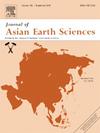Stratigraphic structure and fault interpretation of the foreland basin system in the middle Taiwan Strait
IF 2.7
3区 地球科学
Q2 GEOSCIENCES, MULTIDISCIPLINARY
引用次数: 0
Abstract
Since 2017, we have conducted several surveys to collect multi-channel seismic (MCS) and ocean-bottom seismometer (OBS) data in the middle Taiwan Strait. From the MCS data analysis, the fault distribution in the middle Taiwan Strait is mainly characterized by the normal faults. However, west of the Changyun Ridge, the fault distribution based on depth migrated sections is dominated by the strike-slip faults characterized by flower structures. The strike-slip faults were initiated between two rifted basins and reactivated after rifting. Based on the focal mechanisms and the striking direction of the faults, the strike-slip faults west of the Changyun Ridge are recognized to be left lateral. Additionally, several east–west trending left-lateral strike-slip faults were found in the middle Taiwan Strait. Based on the MCS data, we found that the changing direction of the strike-slip faults occurred in the middle Taiwan Strait before the formation of Taiwan, and was directly subject to the westward compression from the Philippine Sea Plate and the relative plate motion of the South China Sea with respect to the Philippine Sea Plate. Several 2.5 km-deep P-wave velocity models in the middle Taiwan Strait were imaged through inversion of refracted and reflected arrivals picked from the OBS data. At the boundary between the forebulge and foredeep, as well as within the sediment layers beneath the BU, a significant velocity gradient of approximately 2 s−1 was observed in both the lateral and vertical directions. Additionally, a fault-induced offset of about 0.2 km was identified in the sedimentary interfaces.

台湾海峡中部前陆盆地体系的地层构造与断裂解释
自2017年以来,我们在台湾海峡中部进行了多次多道地震(MCS)和海底地震仪(OBS)数据采集。从MCS资料分析来看,台湾海峡中部断层分布以正断层为主。而在长云岭以西,以深度偏移剖面为基础的断层分布以花状构造的走滑断层为主。走滑断裂在两个裂陷盆地之间形成,并在裂陷后恢复活动。根据震源机制和断层走向,认为长云岭以西走滑断层为左侧。此外,在台湾海峡中部还发现了几条东西向的左旋走滑断裂。根据MCS资料,我们发现台湾海峡中部走滑断层的方向变化发生在台湾形成之前,并直接受到菲律宾海板块向西挤压和南海相对菲律宾海板块的相对板块运动的影响。通过反演台海地震仪数据中的折射波和反射波,对台湾海峡中部几个2.5 km深的纵波速度模型进行了成像。在前隆起和前深之间的边界,以及在BU下方的沉积层内,在横向和垂直方向上都观察到一个显著的约2 s−1的速度梯度。此外,在沉积界面处发现了约0.2 km的断层诱发偏移。
本文章由计算机程序翻译,如有差异,请以英文原文为准。
求助全文
约1分钟内获得全文
求助全文
来源期刊

Journal of Asian Earth Sciences
地学-地球科学综合
CiteScore
5.90
自引率
10.00%
发文量
324
审稿时长
71 days
期刊介绍:
Journal of Asian Earth Sciences has an open access mirror journal Journal of Asian Earth Sciences: X, sharing the same aims and scope, editorial team, submission system and rigorous peer review.
The Journal of Asian Earth Sciences is an international interdisciplinary journal devoted to all aspects of research related to the solid Earth Sciences of Asia. The Journal publishes high quality, peer-reviewed scientific papers on the regional geology, tectonics, geochemistry and geophysics of Asia. It will be devoted primarily to research papers but short communications relating to new developments of broad interest, reviews and book reviews will also be included. Papers must have international appeal and should present work of more than local significance.
The scope includes deep processes of the Asian continent and its adjacent oceans; seismology and earthquakes; orogeny, magmatism, metamorphism and volcanism; growth, deformation and destruction of the Asian crust; crust-mantle interaction; evolution of life (early life, biostratigraphy, biogeography and mass-extinction); fluids, fluxes and reservoirs of mineral and energy resources; surface processes (weathering, erosion, transport and deposition of sediments) and resulting geomorphology; and the response of the Earth to global climate change as viewed within the Asian continent and surrounding oceans.
 求助内容:
求助内容: 应助结果提醒方式:
应助结果提醒方式:


